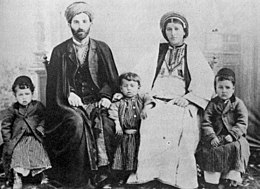
Back Ureueng Filastin ACE Palestyne Afrikaans Palestins AN فلسطينيون Arabic فلسطينيين ARZ Pueblu palestín AST Fələstinlilər Azerbaijani فیلیسطینلی AZB Wang Paléstina BAN Палесцінцы Byelorussian
| Palestinesi الفلسطينيون (al-Filasṭīniyyūn) | ||||||||||||||||||||||||||||||||||||||||||
|---|---|---|---|---|---|---|---|---|---|---|---|---|---|---|---|---|---|---|---|---|---|---|---|---|---|---|---|---|---|---|---|---|---|---|---|---|---|---|---|---|---|---|
 | ||||||||||||||||||||||||||||||||||||||||||
| Sottogruppi | arabi israeliani, samaritani | |||||||||||||||||||||||||||||||||||||||||
| Luogo d'origine | ||||||||||||||||||||||||||||||||||||||||||
| Popolazione | ~ 12,37 milioni (2015)[1] | |||||||||||||||||||||||||||||||||||||||||
| Lingua | arabo palestinese | |||||||||||||||||||||||||||||||||||||||||
| Religione | islam sunnita, cristianesimo, dottrina drusa, samaritanesimo | |||||||||||||||||||||||||||||||||||||||||
| Gruppi correlati | altri arabi | |||||||||||||||||||||||||||||||||||||||||
| Distribuzione | ||||||||||||||||||||||||||||||||||||||||||
| ||||||||||||||||||||||||||||||||||||||||||
I palestinesi (in arabo الفلسطينيون?, al-Filasṭīniyyūn) costituiscono un popolo di etnia araba originario della Palestina.[8][9][10][11][12][13][14][15][16] Nonostante l'esodo del 1948, circa metà dei palestinesi nel mondo continua a vivere negli stati di Palestina e Israele all'interno della Palestina storica,[1] dove i palestinesi costituiscono circa metà della popolazione (mentre l'altra metà è composta da ebrei israeliani).[17]
- ^ a b c d e f Palestinians at the End of 2015, in Palestinian Central Bureau of Statistics (PCBS), 30 dicembre 2015. URL consultato il 20 giugno 2016 (archiviato dall'url originale il 3 maggio 2023).
- ^ a b c d e f g h (EN) Joshua Project, Arab, Palestinian Ethnic People in all Countries, su joshuaproject.net, Joshua Project. URL consultato il 20 giugno 2016.
- ^ (ES) La Ventana - Littin: «Quiero que esta película sea una contribución a la paz», su laventana.casa.cult.cu. URL consultato il 22 aprile 2009 (archiviato dall'url originale il 22 luglio 2009).
- ^ (EN) American FactFinder, su Factfinder.census.gov. URL consultato il 22 aprile 2009 (archiviato dall'url originale il 21 maggio 2008).
- ^ Governo do Estado de São Paulo - Memorial do Imigrante Archiviato il 25 aprile 2006 in Internet Archive.
- ^ Factsheet: Palestinian Refugees in Iraq Archiviato il 20 luglio 2009 in Internet Archive.
- ^ (EN) Ethnic Origin (247), Single and Multiple Ethnic Origin Responses (3) and Sex (3) for the Population of Canada, Provinces, Territories, Census Metropolitan Areas and Census Agg..., su www12.statcan.ca, 2.statcan.ca. URL consultato il 22 aprile 2009 (archiviato dall'url originale il 12 luglio 2020).
- ^ Palestina, in Treccani.it – Enciclopedie on line, Roma, Istituto dell'Enciclopedia Italiana. URL consultato il 18 maggio 2014.«Dopo il 1948, pertanto, la storia della P. venne a identificarsi, in larga misura, con quella dello Stato di Israele. Malgrado questa situazione la popolazione arabo-palestinese riuscì a mantenere un sentimento di identità nazionale e fin dagli anni 1950 i Palestinesi diedero vita a una resistenza culturale, politica e militare»
- ^ (EN) Alan Dowty, Israel/Palestine, Londra, Polity, 2008, p. 221, ISBN 978-0-7456-4243-7.«Palestinians are the descendants of all the indigenous peoples who lived in Palestine over the centuries; since the seventh century, they have been predominantly Muslim in religion and almost completely Arab in language and culture»
- ^ (EN) Bassam Abu-Libdeh, Peter D. Turnpenny e Ahmed Teebi, Genetic Disease in Palestine and Palestinians, in Dhavendra Kuma (a cura di), Genomics and Health in the Developing World, Oxford University Press, 2012, pp. 700-711, ISBN 0-19-537475-4.«Palestinians are an indigenous people who either live in, or originate from, historical Palestine… Although the Muslims guaranteed security and allowed religious freedom to all inhabitants of the region, the majority converted to Islam and adopted Arab culture»
- ^ (EN) Moshe Gil, A History of Palestine, 634-1099, Cambridge University Press, 1997 [1983], pp. 222-3, ISBN 0-521-59984-9.«David Ben-Gurion and Yitzhak Ben-Zvi claimed that the population at the time of the Arab conquest was mainly Christian, of Jewish origins, which underwent conversion to avoid a tax burden, basing their argument on 'the fact that at the time of the Arab conquest, the population of Palestine was mainly Christian, and that during the Crusaders’ conquest some four hundred years later, it was mainly Muslim. As neither the Byzantines nor the Muslims carried out any large-scale population resettlement projects, the Christians were the offspring of the Jewish and Samaritan farmers who converted to Christianity in the Byzantine period; while the Muslim fellaheen in Palestine in modern times are descendants of those Christians who were the descendants of Jews, and had turned to Islam before the Crusaders’ conquest»
- ^ (EN) Nabih Amin Faris, (Palestine) From the Arab Conquest to 1900, in Encyclopædia Britannica, 9 settembre 2013. URL consultato il 18 maggio 2014.«The process of Arabization and Islamization was gaining momentum there. It was one of the mainstays of Umayyad power and was important in their struggle against both Iraq and the Arabian Peninsula… Conversions arising from convenience as well as conviction then increased. These conversions to Islam, together with a steady tribal inflow from the desert, changed the religious character of Palestine’s inhabitants. The predominantly Christian population gradually became predominantly Muslim and Arabic-speaking. At the same time, during the early years of Muslim control of the city, a small permanent Jewish population returned to Jerusalem after a 500-year absence»
- ^ (EN) Peter Marshall Fraser, The Term "Palestinian", in Encyclopædia Britannica, 9 settembre 2013. URL consultato il 18 maggio 2014.«The Arabs of Palestine began widely using the term Palestinian starting in the pre–World War I period to indicate the nationalist concept of a Palestinian people. But after 1948—and even more so after 1967—for Palestinians themselves the term came to signify not only a place of origin but also, more importantly, a sense of a shared past and future in the form of a Palestinian state»
- ^ (EN) Bernard Lewi, Semites and Anti-Semites, An Inquiry into Conflict and Prejudice, New York, W. W. Norton & Company, 1999, p. 169, ISBN 0-393-31839-7.
- ^ (EN) Michael Prior, Zionism and the State of Israel: A Moral Inquiry, Psychology Press, 1999, p. 201, ISBN 0-415-20462-3.
- ^ (EN) James Parkes, Whose Land? A History of the Peoples of Palestine, Londra, Penguin Books, 1970 [1949], pp. 209-210, ISBN 0-14-021089-X.
- ^ Population parity in historic Palestine raises hard questions for Israel, in Reuters, 10 settembre 2015.